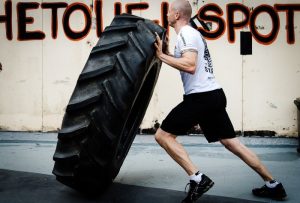
Forget dusty dumbbells and boring treadmills! Kettlebells, those quirky cannonballs with handles, are here to revolutionize your workout. Prepare to unleash your inner warrior (or at least your inner slightly-sweatier self) as we delve into the surprisingly versatile world of kettlebell exercises. We’ll cover everything from beginner-friendly swings to advanced snatches, all while ensuring you avoid looking like a confused octopus flailing around a weight.
This comprehensive guide will equip you with the knowledge and confidence to conquer kettlebell training, whether you’re a fitness newbie or a seasoned pro. We’ll explore how these deceptively simple tools can sculpt your physique, boost your cardiovascular health, and generally make you feel like a total badass. Get ready to swing, snatch, and sweat your way to a fitter, stronger you!
Kettlebell Exercise Basics
So, you’ve decided to join the iron-sphere revolution? Welcome, comrade! Kettlebells aren’t just for intimidating gym bros; they’re a fantastic way to build strength, endurance, and coordination – all while looking incredibly stylish (okay, maybe that’s subjective). This guide will equip you with the foundational knowledge to wield these cannonballs of fitness safely and effectively.
Kettlebell training centers around functional movements, mimicking real-world actions like lifting, swinging, and carrying. This holistic approach strengthens your entire body, improving not only your physical prowess but also your balance and stability. Unlike traditional weightlifting, kettlebell exercises often involve ballistic movements, generating power through momentum and engaging multiple muscle groups simultaneously. This leads to impressive calorie burn and overall fitness improvements.
Essential Safety Precautions for Kettlebell Exercises
Before you start flinging iron around like a Cossack blacksmith, safety first! Ignoring these precautions could lead to injury – and nobody wants that. A little forethought goes a long way.
| Pre-Workout | During the Workout | Post-Workout | General Safety |
|---|---|---|---|
| Proper warm-up, including dynamic stretching. | Maintain proper form throughout each repetition. Don’t sacrifice form for reps. | Cool-down with static stretching. | Use a spotter, especially when starting. |
| Assess your fitness level and choose appropriate weight. Start light! | Listen to your body and stop if you feel pain. | Hydrate adequately. | Ensure sufficient space around you. |
| Wear appropriate clothing and footwear. | Breathe correctly – exhale during exertion. | Apply ice to any sore muscles. | Use a stable, even surface. |
| Consult a doctor or physical therapist if you have any pre-existing conditions. | Avoid jerky movements. | Record your progress to track improvement. | Understand the exercise before attempting it. |
Proper Form for Common Kettlebell Movements
Mastering the form is crucial for effective and injury-free kettlebell training. Think of it like learning to ride a bike – once you get the hang of it, it’s smooth sailing (or should we say, smooth swinging?). We’ll focus on three fundamental movements.
Kettlebell Swings
The kettlebell swing is the cornerstone of many kettlebell routines. It’s a powerful hip-hinge movement that builds explosive power in your posterior chain (glutes, hamstrings, lower back). Imagine you’re chopping wood – that’s the motion you’re aiming for. The kettlebell should move in a pendulum-like arc, driven by your hips, not your arms. Keep your back straight and core engaged throughout the movement.
Avoid rounding your back – this is a common mistake that can lead to injury. The kettlebell should swing between your legs and then rise to approximately chest height. The power comes from the hips and legs; the arms act as guides.
Kettlebell Snatches
The kettlebell snatch is a more advanced movement that requires significant strength, coordination, and technique. It involves a full-body explosive movement where the kettlebell is lifted from the ground to overhead in a single fluid motion. It’s a powerful exercise that builds incredible strength and power, but requires a solid foundation in the swing before attempting. The movement should be a continuous flow, not a series of jerky motions.
Maintain a tight core and keep your back straight. Control the descent of the kettlebell to avoid injury.
Kettlebell Cleans
The kettlebell clean is another dynamic movement that combines elements of the swing and the snatch. The kettlebell is lifted from the ground to the rack position (resting on your shoulder) in a powerful, controlled movement. Similar to the swing, the power comes from the hips and legs. The kettlebell should be racked securely against your shoulder, not simply held there.
Maintaining a stable and upright posture throughout the movement is key to avoiding injury. Smooth transitions are crucial for this exercise.
Kettlebell Exercises for Strength Building
Prepare yourself to unleash your inner beast! Kettlebells aren’t just for those trendy fitness influencers; they’re a seriously effective tool for building raw, functional strength. Forget those isolating bicep curls – kettlebells challenge your entire body, building strength and stability simultaneously. We’ll explore beginner, intermediate, and advanced routines, revealing the kettlebell’s surprisingly potent strength-building secrets.
Beginner Kettlebell Workout Routine
This routine focuses on foundational movements and proper form. Remember, quality over quantity is key, especially when starting. Focus on controlled movements and avoid swinging too heavy too soon. You’ll be surprised how challenging these exercises can be, even with lighter weights.
- Goblet Squats: 10-12 repetitions. Hold the kettlebell vertically against your chest, keeping your back straight and squatting deeply. Imagine sitting back into a chair.
- Kettlebell Swings: 15-20 repetitions. Hinge at the hips, keeping your back straight, and swing the kettlebell between your legs and up to chest height. Power comes from your hips, not your arms.
- Kettlebell Rows: 10-12 repetitions per side. Hinge at the hips, maintaining a straight back, and row the kettlebell towards your chest. Squeeze your shoulder blades together at the top of the movement.
- Turkish Get-Ups: 5-8 repetitions per side. This full-body exercise works wonders for strength and stability. Start lying on your back and gracefully transition to a standing position while holding the kettlebell overhead.
Intermediate Kettlebell Workout Routine
Ready to crank it up a notch? This routine incorporates more complex movements and heavier weights. Remember to listen to your body and adjust the weight as needed. Proper form is still paramount to avoid injury.
- Clean and Press: 8-12 repetitions. This dynamic movement combines a clean (lifting the kettlebell from the ground to your shoulders) with an overhead press. Focus on controlled movements and a strong core.
- Snatch: 6-10 repetitions per side. The kettlebell snatch is a full-body explosive movement that requires power and coordination. It’s a challenging exercise that builds incredible strength and stamina. Start light and focus on perfecting the technique.
- Windmills: 8-12 repetitions per side. This exercise builds incredible core strength and shoulder mobility. Maintain a straight arm and leg, and focus on controlled movements.
- One-Arm Rows: 10-12 repetitions per side. This unilateral exercise targets the back muscles effectively, improving strength and stability.
Advanced Kettlebell Program
This program targets specific muscle groups with challenging variations and higher rep ranges. Expect to feel the burn! This is not for the faint of heart – ensure you have a solid foundation in kettlebell techniques before attempting this routine.
| Exercise | Sets | Reps | Muscle Group Focus |
|---|---|---|---|
| Pistol Squats (with kettlebell for assistance) | 3 | 8-10 per leg | Legs, Glutes |
| Heavy Kettlebell Swings | 4 | 15-20 | Posterior Chain (Glutes, Hamstrings, Back) |
| One-Arm Clean and Jerk | 3 | 6-8 per side | Shoulders, Triceps, Legs |
| Dragon Flags (with kettlebell weight) | 3 | As many reps as possible | Core |
| Kettlebell Handstand Push-ups (against a wall) | 3 | 5-8 | Shoulders, Triceps |
Benefits of Kettlebell Training for Strength Building Compared to Traditional Weightlifting
Kettlebell training offers unique advantages over traditional weightlifting. The dynamic movements engage multiple muscle groups simultaneously, improving functional strength and building overall power. Traditional weightlifting often focuses on isolated muscle groups, while kettlebells provide a more holistic approach to strength development. Kettlebell training also improves cardiovascular fitness, coordination, and flexibility, making it a highly effective and versatile method for building strength and overall fitness.
Moreover, the compact nature of kettlebell training makes it ideal for individuals with limited space or access to traditional gym equipment.
Kettlebell Exercises for Cardiovascular Health
Forget the monotonous treadmill; kettlebells are here to revolutionize your cardio routine! They offer a dynamic, full-body workout that torches calories and strengthens your heart, all while keeping things exciting and preventing that dreaded “cardio boredom.” Prepare to sweat, build muscle, and feel the invigorating burn of a truly effective cardiovascular workout.Kettlebell training provides a unique blend of cardiovascular and strength training benefits, surpassing the limitations of traditional cardio alone.
While steady-state cardio like jogging improves endurance, kettlebell workouts incorporate bursts of intense activity followed by brief recovery periods, mimicking the demands of high-intensity interval training (HIIT). This approach not only improves cardiovascular fitness but also boosts metabolism, increases muscle mass, and enhances overall body composition, resulting in a more efficient and effective calorie-burning machine. This is not your grandma’s aerobics class; this is powerful, efficient, and frankly, quite fun.
A Kettlebell Circuit for Cardiovascular Fitness
This circuit combines several kettlebell exercises to create a challenging yet rewarding cardiovascular workout. Remember to consult your physician before starting any new workout routine. Perform each exercise for 45 seconds, followed by 15 seconds of rest. Complete the entire circuit three times for a killer cardio session. Remember to focus on proper form to avoid injury.
- Kettlebell Swings: Imagine you’re chopping wood with a powerful, fluid motion. This exercise works your posterior chain (glutes, hamstrings, back) and gets your heart pumping.
- Kettlebell Goblet Squats: Hold the kettlebell close to your chest and squat down, keeping your back straight and chest up. This classic exercise targets your quads, glutes, and core while increasing your heart rate.
- Kettlebell Rows: With one hand on a bench and the kettlebell in the other, row the weight towards your chest, squeezing your back muscles. Alternate sides. This builds upper body strength and gets your heart racing.
- Kettlebell Clean and Press: A dynamic exercise combining a powerful hip hinge with a shoulder press. This is a full-body movement that will challenge your cardiovascular system and build impressive strength.
- Kettlebell Turkish Get-Ups: A full-body exercise that improves strength, coordination, and cardiovascular fitness. It involves a controlled movement from a lying position to standing, holding the kettlebell throughout. This one is a real test of endurance!
Kettlebell Exercises Effective for Cardiovascular Fitness
The beauty of kettlebells lies in their versatility. Many exercises can significantly boost your cardiovascular health. Choosing a variety ensures you work different muscle groups and prevent plateaus.
- Kettlebell Swings (various variations)
- Kettlebell Snatches
- Kettlebell Cleans
- Kettlebell Jerks
- Kettlebell Goblet Squats
- Kettlebell Rows (single-arm and double-arm)
- Kettlebell Windmills
- Kettlebell Turkish Get-Ups
Kettlebell Exercises for Different Fitness Levels
Kettlebells: they’re not just for burly bearded men anymore! Whether you’re a fitness newbie tentatively dipping your toe in the iron waters, or a seasoned athlete looking to spice things up, kettlebells offer a fantastically versatile workout for all levels. This section will break down suitable exercises and modifications to ensure you’re swinging safely and effectively, regardless of your current fitness journey.
Beginner Kettlebell Exercises
Beginners should focus on mastering proper form before increasing weight or complexity. This phase emphasizes building a solid foundation of strength and technique to prevent injury. It’s better to do a few reps correctly than many reps incorrectly.
- Kettlebell Swings (American): Start with a light kettlebell (8-12kg for men, 5-8kg for women). Focus on the hip hinge movement, keeping your back straight and core engaged. Avoid using momentum solely from your arms.
- Goblet Squats: Hold a kettlebell vertically against your chest. Squat down, keeping your back straight and chest up. This builds lower body strength and improves balance.
- Kettlebell Rows (single arm): Place one knee and hand on a bench, keeping your back straight. Pull the kettlebell up towards your chest, squeezing your shoulder blades together. This strengthens your back muscles.
Intermediate Kettlebell Exercises
Once you’ve mastered the basics and feel comfortable with the movements, you can progress to more challenging exercises and increase the weight. Remember, proper form is paramount – even as you increase intensity.
- Turkish Get-Ups: This full-body exercise challenges strength, balance, and coordination. Start with a lighter weight and focus on controlled movements throughout the entire exercise.
- Kettlebell Clean and Press: This dynamic exercise combines a clean (lifting the kettlebell from the floor to the shoulder) with a press (pressing the kettlebell overhead). It demands significant strength and coordination.
- Kettlebell Snatch: A more advanced movement, the snatch involves a powerful, explosive lift from the floor to overhead in one fluid motion. This requires significant strength and technique; start with a very light weight and work with a qualified instructor.
Advanced Kettlebell Exercises
For advanced users, the focus shifts towards increasing weight, reps, sets, and incorporating more complex movements. This stage demands a high level of fitness, strength, and technique. Consider working with a personal trainer to ensure proper form and avoid injury.
- Double Kettlebell Clean and Jerk: This highly demanding exercise requires significant strength and coordination. The weight used should be challenging but manageable with perfect form.
- Double Kettlebell Snatch: Performing snatches with two kettlebells simultaneously requires exceptional strength, balance, and coordination. This should only be attempted by individuals with extensive kettlebell experience.
- Advanced variations of existing exercises: This could involve incorporating pauses, isometric holds, or unilateral movements (single-leg or single-arm exercises) to increase the challenge.
Kettlebell Exercise Progression Plan
A sample progression plan might look like this:
- Weeks 1-4: Focus on mastering the beginner exercises with light weight and low reps (8-12 reps, 2-3 sets).
- Weeks 5-8: Increase the weight slightly and reps to 10-15 reps, 3 sets. Introduce one intermediate exercise.
- Weeks 9-12: Increase weight further and reps to 12-15 reps, 3-4 sets. Introduce another intermediate exercise.
- Weeks 13 onwards: Begin incorporating advanced exercises, gradually increasing weight and complexity. Consider adding variations to your existing exercises.
Remember to always prioritize proper form over weight or speed. Listen to your body and take rest days when needed. Consider consulting with a healthcare professional or certified kettlebell instructor before starting any new workout routine.
Kettlebell Exercises and Health Fitness
Kettlebells: they’re not just for intimidating gym bros anymore! These iron orbs are a surprisingly versatile tool for boosting overall health and well-being, offering a potent blend of strength training, cardiovascular exercise, and even a touch of mindfulness (if you’re into that sort of thing). Forget boring treadmills and isolating weight machines – kettlebells offer a full-body workout that will leave you feeling stronger, more balanced, and ready to conquer your day (or at least, ready for a well-deserved nap).Kettlebell training’s impact on overall health and well-being is significant.
It’s not just about aesthetics; it’s about building a healthier, more resilient you. Regular use improves cardiovascular health, strengthens bones and muscles, and enhances coordination and balance, all contributing to a better quality of life.
Improved Posture and Balance
Poor posture is a modern plague, leading to back pain, neck stiffness, and a generally slumped-over demeanor. Kettlebell exercises, particularly those focusing on core strength and stability, directly counteract this. Swings, Turkish get-ups, and cleans all engage the deep core muscles, strengthening the muscles that support the spine and improving posture. The dynamic movements also enhance balance and coordination, reducing the risk of falls, especially important as we age.
Imagine walking with confidence, head held high, a picture of poise and grace (or at least, a significant improvement on your current posture).
Weight Management and Fat Loss
Kettlebell workouts are incredibly effective for weight management and fat loss. The high-intensity nature of many exercises significantly boosts your metabolism, leading to increased calorie burn during and after your workout. Furthermore, building muscle mass through kettlebell training increases your resting metabolic rate, meaning you burn more calories even when you’re not exercising. Combine this with a balanced diet, and you have a winning recipe for shedding those extra pounds.
Think of it as a full-body fat-burning furnace, fueled by your own hard work.
Comparison with Other Fitness Methods
Compared to traditional weightlifting, kettlebell training offers a more functional and dynamic approach. While weightlifting isolates muscle groups, kettlebell exercises often involve multiple muscle groups simultaneously, mimicking real-world movements. Compared to cardio-only routines, kettlebells provide the added benefit of building strength and muscle mass, leading to a more complete fitness profile. Yoga and Pilates focus on flexibility and mindfulness, while kettlebells offer a powerful complement by building the strength and stability needed to perform these activities with greater ease and precision.
Examples of Kettlebell Exercises and Their Impact
Here are a few examples of kettlebell exercises and the muscle groups they target:
The Kettlebell Swing: This dynamic movement primarily targets the posterior chain – glutes, hamstrings, and lower back – while also engaging the shoulders and core for stabilization. It’s a fantastic full-body exercise that improves power and explosive strength.
The Kettlebell Turkish Get-Up: A truly challenging exercise that works almost every muscle group in the body. It emphasizes core stability, shoulder strength, and hip mobility, while improving coordination and balance. It’s a testament to functional fitness.
Kettlebell Goblet Squat: This variation of the classic squat holds the kettlebell close to the chest, emphasizing quadriceps, glutes, and hamstrings. It also improves core stability and posture. A simple yet highly effective exercise.
Kettlebell Clean and Press: This explosive movement works the entire body, from legs and core to shoulders and triceps. It’s a great exercise for building overall strength and power. A true test of coordination and strength.
Kettlebell Rows: This exercise focuses on the back muscles, particularly the lats and rhomboids, improving posture and upper body strength. It’s a great way to counter the effects of prolonged sitting.
Illustrative Examples of Kettlebell Exercises

Let’s get down to brass tacks – or rather, iron tacks – and explore some seriously effective kettlebell exercises. These aren’t your grandma’s weights; we’re talking about dynamic movements that will challenge your strength, endurance, and coordination. Prepare to be amazed (and maybe a little sore).
The Turkish Get-Up
The Turkish Get-Up (TGU) is more than just an exercise; it’s a full-body movement that builds strength, stability, and coordination like a boss. Think of it as a sophisticated full-body awakening, not just a weight lift. It’s a complex movement, but mastering it will reap significant rewards.The TGU involves a series of controlled movements, transitioning from a lying position to standing and back again, all while holding a kettlebell.
The key is maintaining a rigid torso and controlled breathing throughout. Let’s break it down phase by phase:
- The Setup: Lie on your back with one leg straight and the other bent at the knee, the kettlebell held in your outstretched arm on the same side as the bent leg. Your gaze is directed towards the kettlebell.
- The Roll-Over: Using your arm and leg strength, roll onto your side, maintaining a straight line from your shoulder to your feet.
- The Half-Kneel: Press yourself up onto your forearm, then to your hand, eventually reaching a half-kneeling position, the kettlebell still held firmly.
- The Lunge: Bring your back leg forward into a lunge position, maintaining balance and core stability.
- The Stand: Rise to a standing position, the kettlebell still held securely. Your body should be aligned, with the kettlebell positioned overhead.
- The Reverse: Carefully reverse the process, returning to the lying position in a controlled manner.
Benefits include improved core strength, shoulder stability, hip mobility, and overall body awareness. It’s a fantastic exercise for building functional strength – the kind that translates to everyday life.
The Goblet Squat
The Goblet Squat is a fundamental exercise, perfect for building lower body strength and improving mobility. It’s named because you hold the kettlebell close to your chest like a goblet (imagine a medieval king, but with better quads). The simplicity of the movement belies its effectiveness.The Goblet Squat involves a deep squat position, with the kettlebell held close to the chest.
Maintaining an upright torso and engaging your core is crucial. Modifications for different fitness levels are easily implemented:
- Beginners: Start with a lighter kettlebell and focus on proper form. You may not be able to squat as deep initially.
- Intermediate: Increase the weight of the kettlebell and work on deepening your squat.
- Advanced: Incorporate variations such as pause squats or jump squats.
Benefits include increased leg strength, improved hip mobility, and core strengthening. It’s a highly versatile exercise that can be adapted to various fitness goals.
The Kettlebell Swing
The Kettlebell Swing is a dynamic movement that builds power, strengthens the posterior chain (glutes, hamstrings, and lower back), and improves cardiovascular fitness. However, proper form is paramount to avoid injury. This is where the hip hinge comes in.The hip hinge is the crucial movement that powers the swing. It’s not a squat; it’s a controlled movement where you initiate the swing from your hips, not your back.
Imagine you’re trying to slam a door shut with your hips, keeping your back straight. This generates explosive power. Variations include the American Swing (kettlebell goes to chest height) and the Russian Swing (kettlebell stays below chest height).
- The Setup: Stand with feet slightly wider than shoulder-width apart, holding the kettlebell between your legs.
- The Hinge: Hinge at the hips, keeping your back straight, and swing the kettlebell back between your legs.
- The Swing: Powerfully drive the kettlebell forward by extending your hips and knees, maintaining a straight back.
- The Return: Let the kettlebell swing back between your legs, controlled by your hips, not your arms.
Proper form prevents injury by engaging the correct muscles and avoiding strain on the lower back. Focus on the hip hinge, maintain a straight back, and don’t let your arms do the work – let your hips be the engine.
Last Point

So, there you have it – a whirlwind tour through the exciting world of kettlebell exercises. From building serious strength to improving your cardiovascular health and even boosting your posture, the humble kettlebell packs a powerful punch. Remember to start slow, focus on proper form, and most importantly, have fun! Now go forth and conquer those kettlebells – your stronger, healthier self awaits!
Questions and Answers
How often should I do kettlebell workouts?
Aim for 2-3 sessions per week, allowing for rest days to recover and prevent injury.
What size kettlebell should I use?
Start with a lighter weight and gradually increase as you get stronger. A good starting point is one you can comfortably manage for 10-15 repetitions.
Do I need a personal trainer to learn kettlebell exercises?
While a trainer can be beneficial, many resources (like this guide!) can teach you proper form. Watch videos, and prioritize correct technique over heavy weight.
Can I use kettlebells if I have back problems?
Consult your doctor or physical therapist before starting any new exercise program, especially if you have pre-existing conditions.





